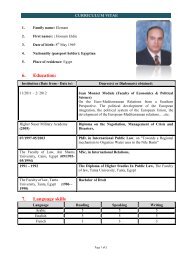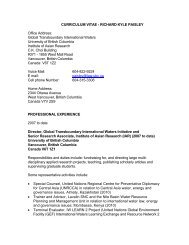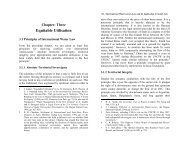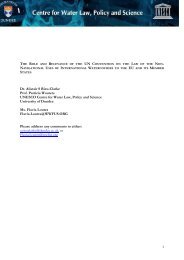Upreti, Trilochan, International Watercourses Law and Its Application ...
Upreti, Trilochan, International Watercourses Law and Its Application ...
Upreti, Trilochan, International Watercourses Law and Its Application ...
You also want an ePaper? Increase the reach of your titles
YUMPU automatically turns print PDFs into web optimized ePapers that Google loves.
Introduction / 7 8 / <strong>International</strong> <strong>Watercourses</strong> <strong>Law</strong> <strong>and</strong> <strong>Its</strong> <strong>Application</strong> in South Asiaapplication of no harm rule for the North American contextinvolves discussion of pollution <strong>and</strong> analyses the failure of theno harm rule in disputes between the US <strong>and</strong> Canada. Theresearch will consider <strong>and</strong> evaluate the existing law on IWC,analyse issues of Nepal’s IWC <strong>and</strong> its link to regional issues,with the objective of assessing current obstacles <strong>and</strong> makingrecommendations for its resolution in the spirit of internationalwater law (IWL). However, the nature of the particularproblems facing Nepal <strong>and</strong> Bhutan are different from those ofother countries. From their point of view, the main problem isnot the lack of water but how to share <strong>and</strong> allocate the benefitsof these abundant water resources, with particular reference toIndia. Whereas, the issues of other riparian states i.e., India <strong>and</strong>Bangladesh, are how to augment the water in the dry season<strong>and</strong> allocate it, <strong>and</strong> also how to avert <strong>and</strong> mitigate the affect offlooding in the monsoon season.Nepal has immense hydropower potential of 83,000 megawatts(MW). Apart from this, these waters can be used for severalpurposes simultaneously 27 e.g., drinking, irrigation,navigational, industrial <strong>and</strong> other uses. So far, little benefit, hasbeen taken 28 , that is to say, vast resources are still not beingtapped. The reasons for this are lack of capital, technology <strong>and</strong>riparian objections. The huge water resources available toNepal have not been beneficially utilised so far. Worse still, inrecent years considerable harm has occurred during the drought<strong>and</strong> monsoon seasons not only in Nepal, but also in India <strong>and</strong>Bangladesh, which have been severely affected by flooding,with huge loss of life <strong>and</strong> property. It is asserted, however, thatif arrangements could be made for the fully beneficial use ofthese resources by all states concerned, it would be a milestoneevent for both the alleviation of poverty <strong>and</strong> the development of27 National Planning Commission (NPC), "The Ninth Plan, 1999-2004”,Kathm<strong>and</strong>u: NPC, (1998), p. 458; also see B. G. Verghese, Waters ofHope, New Delhi: Oxford & IBH Pub., 1990, p. 337.28 Ibid. Less then 19% people have access to electricity, only 45%irrigation facility has been provided so far.infrastructure within all four of the member states of the SouthAsia Association for Regional Co-operation (SAARC). 29 Theadvantages identified so far, are flood control, increasedvolume of water for irrigation (downstream benefits),navigation, recreation <strong>and</strong> miscellaneous other benefits. 30Tremendous harm is caused annually by flooding 31 <strong>and</strong>drought, which could be prevented by international cooperation,<strong>and</strong> the scenario could be reversed by adopting newmeasures for mitigating <strong>and</strong> averting flood water. <strong>International</strong>co-operation on the use <strong>and</strong> sharing the immense benefits ofthese resources has been duly acknowledged but divergence ofinterests, suspicion, distrust <strong>and</strong> non-cooperation have severelyprohibited such opportunities. There is a huge potential beingwasted, that could be utilised by co-operation. 32In order to fulfil the needs <strong>and</strong> aspirations of the people, use ofthese abundant resources is urgently required. It can only bechanged by the states themselves. In the past, few projects weredeveloped, <strong>and</strong> even these projects could not yield equitable<strong>and</strong> reasonable benefits to the parties. What is more,implementation of previous agreements was not carried out29 Ibid. p 393, there are four states Bhutan, Nepal, India <strong>and</strong> Bangladeshwithin the SAARC Quadrangle.30 Ibid. p 465.31 Staff, “Flood Havoc” , The Independent, 5 September 1988: the entirel<strong>and</strong>scape looked as if it had been hit by a brown snowstorm, with justa few village houses <strong>and</strong> same trees rising above it. One whole bank ofthe Ganges was completely submerged, which made the other side ofthe river appear to be the coastline” quoted by an observer. Also seestaff, “Flood in south Asia” The Guardian, 5 September 1988, 25million people were left homeless, more than a thous<strong>and</strong> died as adirect result of the floods, <strong>and</strong> three million tons of rice were lost. Onevillager, who had taken refuge on his roof, described other hardships;“I stay awake through the night to protect my children from deadlysnakes, which often climb on the roof.”32 B. Subba, Himalayan Waters, Kathm<strong>and</strong>u: Panos South Asia, 2001, p.225; also see S. P. Subedi, “Hydro-Diplomacy in South Asia: TheConclusion of the Mahakali <strong>and</strong> Ganges River Treaties” (1999) 93AJIL, pp. 953-962.












